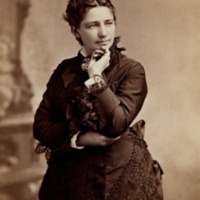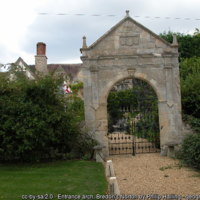Description
Bredon’s Norton was the site of an old Tudor manor house which became the setting for a highly successful and popular Mayflower celebration during the tercentenary year of the voyage in 1920. One of the primary reasons for its success was the involvement of Victoria Woodhull Martin, who lived at Bredon’s Norton. Victoria Woodhull (1838-1927) had been born in Ohio and made a name for herself in America as a fiery campaigner for women’s rights. In 1872, she became the first woman ever to run for President of the United States. The civil rights campaigner and former slave, Frederick Douglass, was to be her running mate.
Although nothing came of her presidential candidacy, Woodhull was famous in America for her support of women’s rights, free love, and socialism. She left America in 1877 and moved to Britain, where she married John Biddulph Martin in 1883. When he died in 1897, Woodhull settled in her late husband’s country estate at Bredon’s Norton and threw herself into philanthropic and educational causes in the locality.
One can easily imagine the kind of forceful personality that would have been necessary to propel a woman from obscure Midwestern roots to presidential candidacy to respectable widowhood as mistress of an English country estate. Throughout her time in Britain, Woodhull threw her copious energies into forging Anglo-American friendship: she was instrumental in helping to purchase Sulgrave Manor, the family home of George Washington, and she was a powerful ally in the Mayflower tercentenary celebrations, particularly in her locality.
The historical pageant at Bredon’s Norton was organised largely through her efforts, alongside fellow members of the Manor House Club. Historical pageants, a sort of amateur re-enactment, were incredibly popular forms of engagement with the past in the early to mid 20th century. They usually took the form of a series of chronological episodes, often starting as far back as the Romans and sometimes coming right up to the present day. The cast was almost always made up of local volunteers, and could be massive - as many as 10,000 people in some cases. You can read more about historical pageants in Britain on this website.
The old Manor House in Bredon Norton's (the entrance archway of which is pictured here) acted as a most fitting backdrop for an elaborate cast of historical characters spanning the years of Good Queen Bess to the sailing of the Mayflower. Gloriana Regina was present in all her splendour, as was Francis Drake, Walter Raleigh, William Shakespeare, and a great many others. To the delight of the assembled cinematographic photographers, the costumed characters spent time milling picturesquely around the grounds of the Manor House before getting down to the serious business of performing the pageant. It was divided into two parts, the first of which told some earlier episodes of mostly Tudor history, with the second focused on the Pilgrim Fathers, particularly Christopher Martin and Edward Winslow, who came from the West Midlands. The pageant emphasised the immediate relationship between America and Britain by glossing over the eleven years the Mayflower voyagers spent in Holland (“a delay”) and moving swiftly on to the perilous journey and its poignant conclusion: “...the Mayflower Pilgrims... rooted in the virgin soil of the New World the finest characteristics of our English-speaking race.” The pageant then showed how, despite the hardships of cold, hunger, and hostility, the colonies of New England and Virginia flourished. The pageant ended with a “Mayflower Ode”, written specifically for the occasion. Its concluding verse was:
Hymns and praises for the past,
Pilgrims of the ages voicing
Joy and song while ages last.
Hallelujah and thanksgiving!
We will keep your children free,
By good laws and righteous living
For the centuries to be.”
Following that, everyone retired to the Manor House for tea.
Source
Gloucester Journal, “Bredon’s Norton Pageant”, 4 September 1920.
L. Goldman, “Woodhull, Victoria Claflin [other married name Victoria Woodhull Martin] (1838-1927)”, Oxford Dictionary of National Biography.

